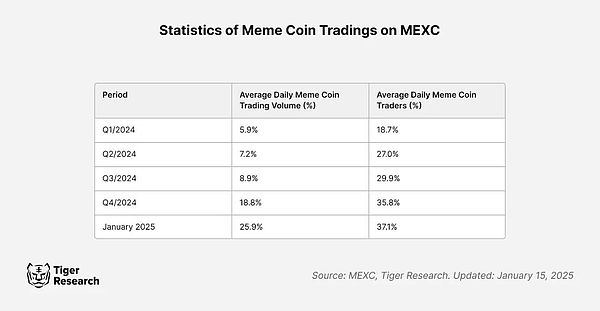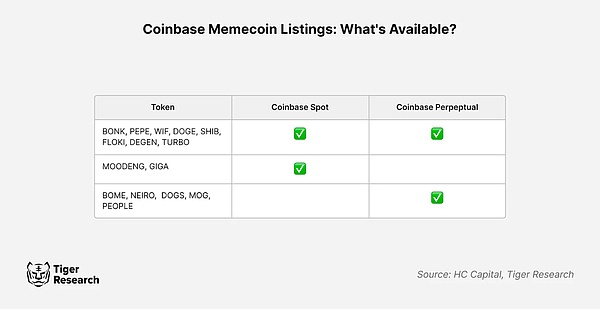Memecoins are redefining the importance of the cryptocurrency market, driving the adjustment of exchange strategies and the rise of the DEX market.
Research Summary
1. Memecoins have transformed from a purely speculative asset to a dominant trading force, not only attracting a large amount of liquidity, but also reshaping the capital flow pattern in the crypto market.
2. Platforms represented by Pump.fun have promoted the rise of decentralized exchanges (DEX), attracting liquidity and active traders, thereby weakening the early price discovery capabilities of centralized exchanges (CEX).
3. Exchanges that quickly adapted to Memecoins trading, such as MEXC, performed strongly, while slower-reacting platforms such as Binance faced the dual challenges of liquidity and market influence.
1. New battlefield of exchanges
Memecoins are redefining the cryptocurrency market. From an initial speculative trend, they have now become an important trading product on major exchanges, driving huge trading volumes.
To adapt to this trend, exchanges have adjusted their strategies. Gate.io and MEXC grabbed market share by listing Memecoins quickly, while Binance launched "Binance Alpha" to focus on listing early Memecoins and provide a smooth transition. In the DEX market, Raydium based on Solana successfully surpassed Uniswap based on Ethereum to become the market leader. This change proves the strong driving force of Memecoins on the market.
As Memecoins continue to gain importance on exchanges, its broader impact is also worth paying attention to. Will Memecoins trading lead a lasting market change or is it just a short-lived cyclical phenomenon? In addition, how will changes in regulatory policies affect the sustainability of Memecoins as a mainstream asset? These questions will determine the future development direction of retail trading and exchanges. 2. DEX breaks through the status quo: Raydium surpasses Uniswap The craze for Memecoins has driven the rapid rise of Raydium. As of January 2025, Raydium has occupied 27% of the DEX market and has become the preferred platform for retail investors. Raydium's success is inseparable from the technical advantages of the Solana chain, which provides lower fees and faster transaction speeds than exchanges on the Ethereum chain. These features make Raydium the core platform for Memecoins transactions.
At the same time, Uniswap's market share slipped from 34.5% in December 2024 to 22% in January 2025, losing its dominance in the DEX market. High Ethereum Gas fees have become a major obstacle for Memecoins traders, which has also caused many cost-sensitive retail investors to turn to other platforms. If Ethereum-based DEXs fail to innovate in a timely manner, they will face greater pressure to transfer liquidity.
Although Memecoins trading has clearly driven Raydium's growth, the sustainability of this trend remains to be seen. Some analysts believe that the craze for Memecoins trading may gradually subside as speculative demand declines. However, Raydium has become a familiar platform for users with the help of Memecoins trading. If it can seize this trend, Raydium is expected to further consolidate its market position by strengthening liquidity pools, optimizing user experience, and building an efficient trading system. These efforts will help Raydium maintain a long-term advantage in the competition between DEX and CEX.
3. CEX's response: Can they keep up with the rise of DEX?

Gate.io and MEXC have successfully attracted a large number of retail investors interested in speculative assets by focusing on the listing strategy of Memecoins. Among them, MEXC has become the leader of this trend with its fast Memecoins listing policy. For example, they opened trading for Memecoins Official Trump ($TRUMP) on the day it was listed, which directly led to record trading volume and rapid growth in the number of users.
These strategies have produced significant results. MEXC's daily Memecoins trading volume soared from 5.9% in the first quarter of 2024 to 25.9% in January 2025. At the same time, the proportion of Memecoins traders also increased from 18.7% to 37.1%. As the world's largest cryptocurrency exchange, Binance is also actively expanding its Memecoins listing scope to attract retail liquidity. Recently, Binance has paid more attention to speculative assets, trying to seize the market opportunities of the "attention economy". However, due to its characteristics as a centralized exchange (CEX), Binance is inevitably restricted by internal review processes. These processes result in Memecoins being listed only when the market heat has already declined or turned to a new trend. Although Binance provides sufficient liquidity to protect investors, this liquidity has become an outlet for early holders to sell Memecoins. Since the sell-off has little impact on the market price, the prices of many newly listed Memecoins generally fell by more than 75% in a short period of time, causing a large number of investors to suffer losses. This situation not only damages Binance's long-term credibility, but also raises questions about its listing review process.

Compared with Binance, major centralized exchanges such as Coinbase, Kraken and Upbit have adopted a more conservative strategy, focusing on proven cryptocurrencies rather than Memecoins. Although this strategy cannot capture short-term high-yield market opportunities, it contributes to the stability of the platform and reduces regulatory risks.
The core challenge of CEX at present is how to find a balance between attracting short-term trading activities and maintaining long-term platform stability, while maintaining the trust of institutional investors and effectively attracting more retail investors.
4. Strategic Summary and Future Prospects
Memecoins have gradually evolved from a simple speculative tool to an important trading variety in the cryptocurrency market. With the substantial growth in Memecoins trading volume on decentralized exchanges (DEX), this trend has brought new opportunities and challenges to the crypto industry.
During the recent bull run, Memecoins on DEXs have significantly outperformed assets listed on centralized exchanges (CEXs), prompting more and more investors to turn to DEXs. Platforms like Pump.fun optimize the issuance and trading process of Memecoins, allowing new tokens to quickly achieve explosive growth even if they are not listed on CEXs.
To adapt to this change, market makers, liquidity providers, and project teams have adjusted their strategies. They are no longer just focusing on CEX listings, but are beginning to pay attention to the DEX environment. They have improved the accessibility and flexibility of trading by establishing liquidity
pools on multiple platforms. However, the Memecoins market still faces many risks. Unethical behaviors such as running away with money, small group manipulation, and malicious transactions have seriously damaged the interests of investors. These problems are common due to the lack of effective supervision in the market. For example, the Argentina Libra ($LIBRA) scandal exposed these potential risks, triggered widespread doubts about Memecoins in the market, and caused a significant drop in the trading volume of Solana DEX.
Despite this, Memecoins still show their potential in the crypto field. They are gradually becoming representative assets of certain entities and groups. For example, Elon Musk's relationship with Dogecoin, Trump's association with Official Trump Token, and some cases of Memecoins issued by startups and countries all show that cryptocurrencies are capturing real economic and social value. This trend has similarities with the securitization process in traditional financial markets and may gradually evolve into a new cultural phenomenon.
In the face of this change, CEX must quickly adjust its strategy. Investors are no longer waiting for CEX to be listed before starting to trade promising assets. In order to attract more users and remain competitive, exchanges need to integrate on-chain functions and DeFi elements while ensuring the stability and compliance of the platform. This flexible and innovative strategy will be key to driving the crypto market into the next stage of growth.
 Weatherly
Weatherly





